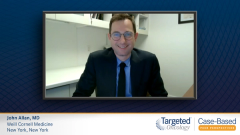
Testing and Risk Stratification in CLL
A key opinion leader shares insight into testing and risk stratification for chronic lymphocytic leukemia.
Episodes in this series

John Allan, MD: The other important aspect of this case is the workup that was done, the baseline workup of the CLL patient. And so, for the most part, the patient has had a full workup, there is a few things that are missing. The iwCLL [international workshop on chronic lymphocytic leukemia] guidelines have updated what is considered standard baseline workup for a CLL patient, and that includes for molecular prognostic factors. And that really includes three big groups of categories.
One is the FISH, the fluorescence in situ hybridization, where you have a CLL FISH panel. 80% of patients with CLL will have one of these five different abnormalities present, and each one that's present may have a different prognosis for the patient. The most common is deletion 13q, presenting in about 50% to 60% of patients of CLL that have abnormality. In this patient, they have a deletion 11q, which while at diagnosis is relatively rare, about 10% to 15% of patients, does identify somebody that might be higher-risk that associates with other high-risk features.
The other big category that should be performed, and this patient did have, is the IgHV mutational status. We've known since the late 1990s that the IgHV mutational status predicts independently an outcome for patient's time to first treatment over progression-free survival, overall survival when used with chemoimmunotherapy and fixed durations. This has identified an unmutated phenotype as a more aggressive CLL. While the aggressive feature still holds before treatment, as we will talk about later, how these new targeted agents have potentially overcome some of these features.
So, this patient had it. There can be even further nuance here by looking at the V-gene that's being used, it's not reported for this specific patient, but sometimes there are higher risk V-genes that are being used such as V3-21, V4-39, V1-69 is frequently an unmutated stereotyped receptor. So, there is a little bit of nuance that you can get with further information by looking at the V-gene that is being used. What really matters is it just mutated or unmutated, unmutated meaning it's 98% the same homology as the germline sequence of that IgHV gene.
The last part that is recommended by the iwCLL guidelines that was not done in this patient, is sequencing for P53 [tumor protein P53] mutations. It's well known that P53 mutations harbor poor outcomes when chemoimmunotherapy is used, very similar to those patients with the del17p [deletion 17p].
Now, you can find a small number of patients, less than 5% of patients, that do not have a del17p, that do have a P53 mutation, and if that mutation is present that's going to clearly steer you away from chemoimmunotherapy as an approach. We get a lot of genes frequently on these large panels that can be sent, and we get a lot of information, there are other high-risk mutations to note, NOTCH1, BIRC3 [baculoviral intra-abdominal pressure repeat-containing protein 3], SF3B1 [splicing factor 3B subunit 1], and other notch regulatory pathway mutations, these all are helpful at predicting a patient that may have more rapidly progressive disease and/or people who might transform on you and/or who are going to do poorly with chemoimmunotherapy.
The one part of this case that is not done, that I would have done. I do these three big groups of testing. I have additionally incorporated karyotyping of my CLL, the iwCLL guidelines do not routinely recommend this in clinical practice, but our cytogenetic lab is able to provide that information. I send that off as well to identify patients with complex karyotype.
One of the questions was, “should I wait on these results before initiating treatment?” I make that easy for myself because I send most of this work up in patients at diagnosis, and so I have this information ready to go and I'm not chasing after it, wondering what's going on when I need to initiate therapy for the patient.
If you are thinking about using chemoimmunotherapy, which can be argued there still may be a small role for, I do recommend that you should wait for these results before initiating treatment. If you identify some of these high-risk features, you absolutely want to steer clear of chemoimmunotherapy. If you send this stuff off and you just start treatment, and then two weeks later you identify the high-risk features but you startedtreatment, you may have done the patient a disservice.
Usually, I have the results because I already kind of know what I'm working with when the patient is requiring therapy, but before treatment you should have these results known to help guide your therapy. These results are prognostic and predictive, so they identify people, but they are now identifying patients who will absolutely do worse with chemoimmunotherapy.
Transcript Edited for Clarity
Initial Presentation
- A 67-year-old man presented to PCP with complaints of fatigue and night sweats
- PMH: patient takes OTC antiacid tablets a few times a week for a “sensitive” stomach
- PE: Enlarged mobile lymph nodes bilaterally (~1.5 cm), no palpable spleen or liver
- Laboratory findings:
- WBC; 102 X 109/L
- Lymphocytes; 79 X 109/L
- Hb; 11.4 g/dL
- Platelets; 180 X 109/L
- ANC; 1,900/mm3
- LDH 1470 U/L
- Cytogenetics; del(11q), IgVH-unmutated
- beta2M, 3.0 mg/L
- Rai Stage I
Treatment Plan
- Patient was started on ibrutinib









































